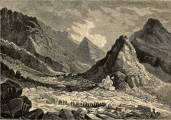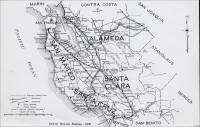


Alameda County
- List of Alameda County – List of Stone Quarries, Etc.
- Alameda County Sandstone (historical times through circa 1904) - Excerpt from The Structural and Industrial Materials of California, Bulletin No. 38, California, State Mining Bureau, San Francisco, California, 1906.
- Alameda County Mineral Industry (circa 1919) - Excerpts from California Mineral Production for 1919, Bulletin No. 88, by Walter W. Bradley, California State Mining Bureau, 1920.
- Alameda County Limestone Industry and Deposits (through 1947) - Excerpts from “Limestone in California,” by Clarence A. Logan, California Journal of Mines and Geology, Vol. 43, No. 3, July 1947, California Division of Mines, San Francisco, California, pp. 175-357.
-
Alameda
County Sandstone (historical times through circa 1904) -
Excerpt from The Structural and Industrial Materials of
California, Bulletin No. 38, California, State Mining
Bureau, San Francisco, California, 1906.
“At present all of the sandstone produced in Alameda is used as macadam, rubble, or concrete. Years ago two quarries produced building stone, but they have been abandoned.”
-
Alameda County
Mineral Industry (circa 1919) - Excerpt from California
Mineral Production for 1919, Bulletin No. 88, by Walter W.
Bradley, California State Mining Bureau, 1920, pp. 142.
“Alameda.
Area: 843 square miles
Population: 344,177 (1920 census).“Alameda County, while in no sense one of the ‘mining counties,’ comes twentieth on the list with a value of mineral products for 1919 of $1,304,685, an increase from 1918 total, which was $1,173,535. The mineral resources of this county include asbestos, brick, chromite, clay, coal, limestone, magnesite, manganese, pyrite, salt, soapstone, and miscellaneous stone.
“Commercial production for 1919 was as follows:”
(Headings for the information below are: Substance, Amount, and Value.)
Chromite, 80 tons, $1,264
Brick and tile, ---, $369,778
Clay (pottery), 5,011 tons, $12,127
Pyrite, 8,978 tons, $42,902
Salt, 157,751 tons, $552,178
Stone, miscellaneous, ---, $309,572
Other minerals,* ---, $16,864
(Total value) $1,304,685(* Includes magnesium salts, manganese, and potash.)
-
Alameda
County Limestone Industry and Deposits (through 1947) -
Excerpts from "Limestone in California," by Clarence
A. Logan, California Journal of Mines and Geology, Vol.
43, No. 3, July 1947, California Division of Mines, San
Francisco, California, pp. 175-357. (Used with permission,
California Department of Conservation, California Geological
Survey.)
Alameda County
"The geology of the western part of Alameda County has been mapped in the San Francisco, Concord, and Hayward quadrangles (Lawson, A. C. 14). Freshwater limestone occurs sparingly in the Orinda, Moraga, and Siesta formations (Pliocene) but in such small deposits in this county that most of them are not shown on the map. One small body on the county line about three-quarters of a mile south of Grizzly Peak is at the contact between the Moraga and Siesta beds. In a paper by Lawson and Palache, (02, pp. 383, 388), these deposits (principally in Contra Costa County) are described as 'compact, light gray rocks of uniform texture.Locally they contain numerous detrital fragments indicating a shallow-water origin for the deposit. They can scarcely be regarded as other than chemically-precipitated deposits although the conditions which determined the precipitation cannot be stated positively.'
"Some small travertine deposits from mineral springs were noted in the Berkeley Hills north of Berkeley but were not shown on the geologic map as they were believed to have been moved by landslides, and not in their original positions. So far as known, such depots have not been worked in Alameda County. Geologically, they are of the Recent series.
"The earliest lime production in the county was made at Mission San Jose, until the local supply of wood fuel was exhausted. Later this locality furnished some marl for agricultural use. There has also been a small production of limestone and lime from a deposit midway between Sunol and Pleasanton. More important than any other deposits in the county are the beds of oyster shells in the southern arm of San Francisco Bay. From 1931 to 1936 California Chemical Corporation and its successor, California Chemical Company, produced lime and shells at their Newark plant. In 1936 the latter company was succeeded by Westvaco Chlorine Products Company who built a plant in 1938 reported to have cost $1,500,000. Sea-water bittern from salt works and oyster shells from the bay are used to make magnesite. Bromine, chemical lime, shells, and gypsum are also produced."
Commercial use of material within this site is strictly prohibited. It is not to be captured, reworked, and placed inside another web site ©. All rights reserved. Peggy B. and George (Pat) Perazzo.
